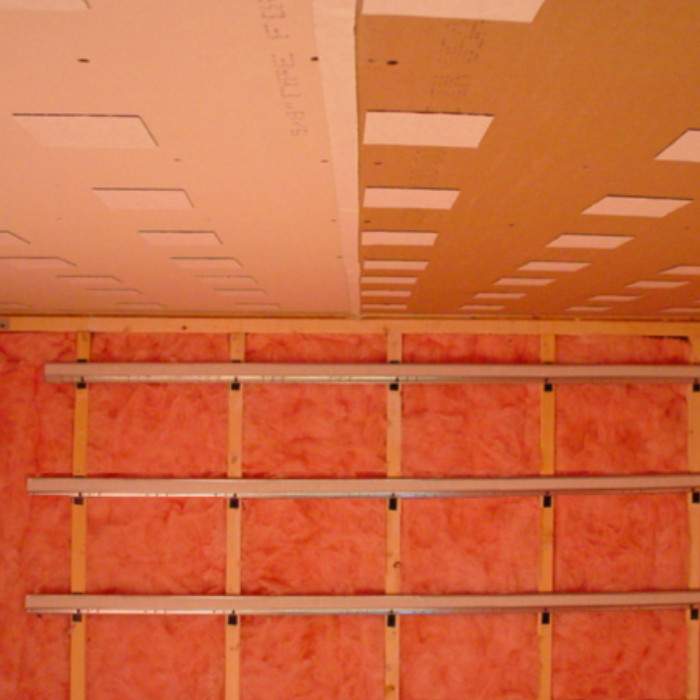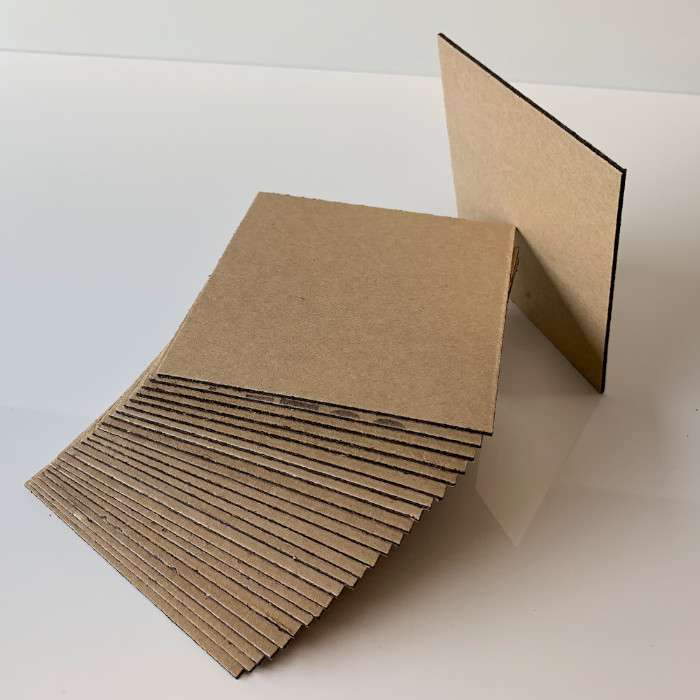How It Works
WallDamp is a solid sheet of constrained layer damping material, which means it works when it is sandwiched between surfaces, with each face of the damping material moving/slipping with the surface it is in contact with. Shear forces are created within the damping material, which are rapidly converted to heat, and the movement is calmed.
Simply remove the release paper from one side of a WallDamp strip or square and press it into position. Remove the next layer of release paper, press the adjoining material against the adhesive, and screw them together. Minimal screws are needed, as the adhesive provides the long-term connection – but always follow all building code fastener schedules! The pressure-sensitive adhesive is compatible with metal, wood, and drywall paper.
The damping coefficient for constrained layer damping depends on the thickness of the damping compound: too thin, it becomes too stiff and if too thick, it becomes too soft. Unlike liquid damping compound, WallDamp can’t be squeezed out of the narrow space between stud/joist faces and drywall by the pressure when sheetrock screws are tightened down which means WallDamp maintains its engineered damping factor.
Sound Isolation
There are three primary mechanisms for reducing structural sound transmission:
- Block the sound by increasing the mass thickness & density of the walls & ceiling.
- Minimize the transmission paths for vibrations and sound to travel though.
- Absorb & damp vibration energy throughout the structural elements.
ASC’s proprietary Iso-Wall System incorporates all three of these methods:
- More than doubles the mass/surface density
- Decoupled “floating” wall & ceilings
- WallDamp constrained layer damping throughout

Here we have two walls, both are made of 8’ wood studs covered with one layer drywall on each side. We thump both walls at the midpoint with a rubber mallet and watch the vibration of the wall. On the left is the vibration of a standard wall construction, such as found in any residential wall and we see the wall vibration lasts about 1 second. To the right we see the same stud wall has been constructed with WallDamp between the stud and the drywall and the wall vibration dies out in about ¼ second – 4 times faster. And count the wall vibrations: undamped shows about 35 oscillations and damped shows only about 5 oscillations.

Blocks Sound Conduction
Add WallDamp between the stud/joist and drywall to block the conduction of sound into the framing, and add insulation or rockwool in the wall cavity to stop airborne conduction of sound. WallDamp weighs about one third the density of steel, and about 5 times the density of wood. This difference creates an impedance mismatch that reflects vibrations instead of transmitting them.
Eliminates Sound Transmission
Add WallDamp between studs and drywall to damp the otherwise free vibration of the drywall that is suspended between the studs. Have you knocked on a wall to find the stud? That hollow sound between studs is the bending vibration of the drywall and is what transmits sound through the wall. WallDamp on the stud face is distorted by this vibration action and absorbs energy out of the vibration. Add Walldamp between adjacent layers of double drywall to dramatically reduce drywall vibration.

Eliminates Wall & Ceiling Shudder
A wall shudders when people walk across the wood floor or close a door. The ceiling shudders from overhead footfall. But when the subwoofer in a home theater or hi fi set is playing, the walls, ceiling, and even the floor will be set into sympathetic vibration. That’s why people in other parts of the house or even next door “turn the bass down”. Adding WallDamp between studs/joists and drywall and between adjacent layers of drywall absorbs the energy of vibration and virtually eliminate wall shudder.
The Source
 Damped Sheetrock is ASC’s premier damping material. It comes as a 4″ square of a thin sheet of damping material with self-stick adhesive on both sides and covered with release paper. Peal the release paper off and place the vibration damping sheet between two layers of sheet rock on l’ centers to sufficiently damp ·the free vibrations of the sheetrock. Here’s an example of two layers of sheetrock before and after bending. Note the relative sliding at the edge, between the sheets.
Damped Sheetrock is ASC’s premier damping material. It comes as a 4″ square of a thin sheet of damping material with self-stick adhesive on both sides and covered with release paper. Peal the release paper off and place the vibration damping sheet between two layers of sheet rock on l’ centers to sufficiently damp ·the free vibrations of the sheetrock. Here’s an example of two layers of sheetrock before and after bending. Note the relative sliding at the edge, between the sheets.

Bass pressure pushes the middle of a wall inward and pulls it outward, which causes the outside edges of a double layer wall to slide back and forth over each other. The middle area of the wall does not slide as it moves in and out. Adding sheer stress damping material between the 2 layers of sheetrock absorbs energy from this sliding action at the edges which then absorbs the bass energy from the room.





















